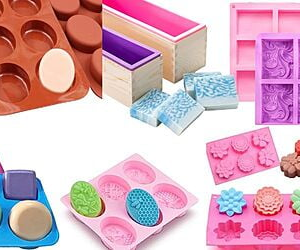When choosing soap making supplies, the right mold shapes your soap and makes it easier to remove the finished bars. You can choose from various materials, each offering unique benefits to create the designs you want for your soap. Whether you want to make small or large batches, these products come in different sizes to suit your project requirements. Here are three different types of soap molds for making your products:
1. Plastic Molds
Plastic molds are available in many designs, including loaf, round, square, and decorative shapes like animals or flowers. Whether you want to create soaps for seasonal holidays, weddings, or personalized gifts, these soap making supplies allow you to shape them. Made from high-quality plastic, these molds can sustain the heat generated during the soap-making process. Many plastic molds feature a smooth finish, which increases the appeal of your finished goods by giving them a neat, polished appearance.
Since plastic is lightweight, you can handle and transport molds easily, making it convenient to move them between different workspaces. Plastic molds are versatile, meaning you can create your soap using different techniques, including cold process, hot process, and melt-and-pour. To prevent sticking and allow for easy removal, you may line your plastic molds with freezer paper or a silicone liner. Plastic molds come in various sizes, including small individual bars and large multi-cavity designs. This lets you produce single-use soaps for gifting and personal use or large batches for your business.
2. Silicone Molds
Silicone molds are flexible, durable, and easy to handle. The material has a non-stick surface, which helps prevent soap from sticking to the mold, making it simple to remove the finished bars. You can bend or twist the mold to release the soap without damaging the original shape or design. The silicone material is easy to clean, saving time in maintaining molds between uses. It can also resist higher temperatures than plastic molds, increasing its suitability for hot-process soap making.
Some silicone molds are clear or semi-transparent, which lets you see the soap inside as it cures. This feature is helpful for monitoring the soap’s curing time and quality without removing it from the mold. You can use these molds in the freezer or oven, allowing you to make layered soap or use techniques that require temperature changes. Silicone molds provide good insulation to prevent edges from drying out quickly. Some also have reinforced edges to create straight lines and minimize bowing.
3. Wooden Molds
Soap makers may use wooden molds to create loaf-shaped soaps that can be sliced into individual bars. Such molds are effective solutions if you want to make larger batches at once and save time. Another benefit of wooden molds is that they are strong enough to handle frequent use, controlling issues like warping and breakage. The weight of these molds helps keep them stable during the pouring process, reducing spills or accidents while working with liquid soap mixtures.
The wood material has a natural texture that can give your final products a rustic touch, enhancing their visual appeal. Each wooden mold has its unique grain and small knots, making soap pieces distinct and special. When using this mold, leave some space at the top to prevent spills and allow for expansion as the soap sets. Lining the wooden mold with traditional freezer paper is also recommended to prevent sticking when removing the soap.
Buy Quality Soap Making Supplies
Different materials, such as wood, plastic, and silicone, allow you to make soap for personal or business use. You can experiment with various methods and styles to create presentable and durable soaps. Buy quality molds from a trusted supplier to make unique homemade soap today.




